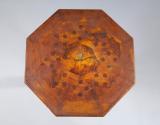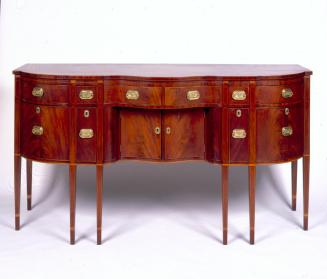Stand
Furniture MakerMade by
Unknown
Date1856-1880
MediumOak, various woods, cast iron
DimensionsPrimary Dimensions (height x width x depth of top): 28 3/8 x 33 x 33 3/8in. (72.1 x 83.8 x 84.8cm)
Component (maximum width between two feet): 17in. (43.2cm)
ClassificationsFurniture
Credit LineConnecticut Museum of Culture and History collection
Object number2006.5.0
DescriptionOak stand in the Rococo Revival style; the top is possibly made with pieces of wood from the Charter Oak. The stand has an octagonal top over a turned wooden pedestal, over a cast iron tripod foot. The top has three concentric bands of veneer, beginning in the center with an octagon made of triangular pieces of veneer. This is surrounded by the widest band of veneer of eight squares separated by triangles. Each square of veneer has four circles of darker veneer, all from the same branch of a tree. The final band of veneer at the edge of the top consists of a nearly rectangular piece of veneer on each side of the octagon, separated by a diamond-shaped piece of veneer. The edge of the top has cyma curve, or S-curve, molding. The turned wooden pedestal includes twelve irregular rings, tapered in diameter from bottom to top, over a wide raised ring. The cast iron foot has three legs each with overall pattern of S-curves and C-curves. Between each leg is a hanging ornament, possibly a flower.
Condition: The top has split from the edge to the center, and been repaired with a long, triangular piece of wood inserted to fill the gap. The veneer in the center of the top has broken off. Additional cracks in the veneer extend all across the top. The cleat has been removed from the underside. The stand is refinished.
Design and Construction Details: The top is made from a base layer of multiple shaped boards that are butted together to form the octagon. The veneer is applied over this, and the molded edge is nailed to the sides of the top. The top is screwed to an octagonal cleat from the underside. The cast iron tripod foot is joined to the base of the pedestal through a system of screws secured with a square nut.
NotesHistorical Note: The Charter Oak, located on the Wyllys estate in Hartford, hid the state's royal charter when a representative of the English government attempted to seize it in 1687. The tree fell down during a storm in 1856. The patriotic story of the Charter Oak has since become a deeply rooted part of Connecticut's history.Condition: The top has split from the edge to the center, and been repaired with a long, triangular piece of wood inserted to fill the gap. The veneer in the center of the top has broken off. Additional cracks in the veneer extend all across the top. The cleat has been removed from the underside. The stand is refinished.
Design and Construction Details: The top is made from a base layer of multiple shaped boards that are butted together to form the octagon. The veneer is applied over this, and the molded edge is nailed to the sides of the top. The top is screwed to an octagonal cleat from the underside. The cast iron tripod foot is joined to the base of the pedestal through a system of screws secured with a square nut.
Status
Not on view









